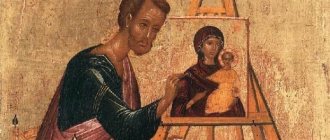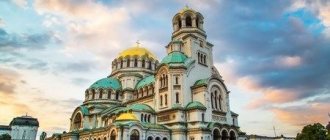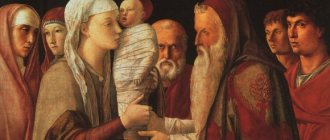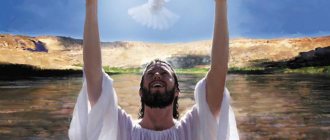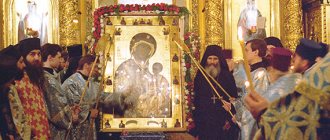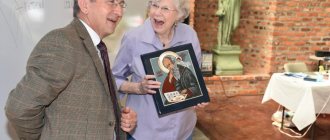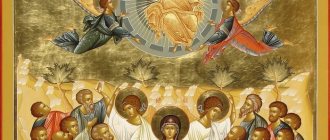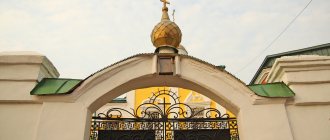August 19 is the day of the celebration of the Transfiguration of the Lord, when Jesus first revealed His Divine hypostasis to His closest disciples. This is one of the most significant evangelical events, which is of great importance even today - it is not for nothing that this holiday is one of the twelve, that is, the twelve most important in Orthodoxy.
Date of celebration: August 19
The icon is based on the story described in all four Gospels. Jesus prophesied to His disciples that He would soon die, but three days later He would rise again. The disciples were saddened, but it was difficult for them to believe in the Teacher’s words about the resurrection, because everyone considered Him a prophet, the Messiah, but did not know His Divine nature.
A few days after this prophecy, He went up to the mountain to pray together with John, Peter and James, who of all the disciples were closest to Him. This is where the event that the Transfiguration of the Lord icon describes took place:
He was transfigured before them: and His face shone like the sun, and His clothes became white as light (Matthew 17:2).
But the miracle did not end there: Elijah and Moses, the Old Testament prophets, appeared next to Jesus and spoke to Him.
about His exodus, which He had to accomplish in Jerusalem (Luke 9:31).
The Transfiguration made an absolutely stunning impression on the disciples, especially when the Voice of God was heard from the cloud that overshadowed everyone:
This is My beloved Son, in whom I am well pleased; Listen to Him (Matt. 17:5).
When the cloud disappeared, Jesus took on his former form and was left alone with his disciples. He forbade them to talk about what they saw,
until the Son of Man rises from the dead (Mark 9:9).
Mandorla
On the icon of the Transfiguration, as on many other icons, the Savior is depicted inside a circle or oval called a mandorla. This is an Italian word meaning "almond". Essentially, it is a large, shining halo that encloses the entire body, if not the entire world. The circle in iconography is one of the most important symbols. Having no beginning or end, it symbolizes eternity and completeness, and the mandorla symbolizes Divine glory. That is, the presence of a mandorla indicates that the Lord at this moment appears to us in all his glory. Often the mandorla consists of rings, "concentric circles", arranged in order of lightening - either towards the center or towards the edges. This emphasizes the movement, the outflow of energy from the heavenly world to the earthly world. Sometimes it is pierced by thin golden or white rays. The color of the mandorla is usually blue or red, sometimes it is gilded. On the icon of the Transfiguration of the Lord by St. Andrei Rublev, the mandorla is depicted as blue-black, impenetrable.
How does the Transfiguration of the Lord icon help?
To celebrate the Transfiguration of the Lord, a solemn liturgy is held, and prayers are offered before the icon for forgiveness of sins and cleansing.
It really helps to cleanse the soul of bad, sinful thoughts and strengthen faith.
Believers not only ask the Lord for help and protection for themselves and loved ones, but also offer him gratitude and praise.
In folk tradition, the Transfiguration of the Lord is also called the Second (Apple) Savior, when the fruits of the new harvest are blessed in churches. On this day, people are supposed to visit the graves of their ancestors and leave apples on them, as well as distribute them to those in need.
Rocks and trees
In those places where the Transfiguration took place, there are gentle, not rocky slopes, but for some reason it is the rocks that are depicted on the icon. This means that the rocks also have their own “spiritual load”, a symbolic meaning in the icon. On the one hand, rocks are stones, a symbol of strong, unshakable faith. On the other hand, mountains are always a symbol of spiritual ascent, and a general cultural symbol that is preserved in painting and literature. They symbolize here the spiritual path that a believer must take in order to achieve transformation, deification. As for the trees, they have not only a direct meaning - that trees really grow on Tabor. The Transfiguration of the Lord is perceived as part of the path to the crucifixion. Therefore, the tree is also a symbol of the Tree of the Cross on which Christ was crucified. And the tree of our salvation.
Prayer before the icon
Lord Jesus Christ, we turn to you with sincere prayers. Save and keep our souls pure, deliver us from self-interest and envy, and do not allow us to step on a path that will lead us astray. We pray to You, show your grace to everyone who has chosen the path filled with righteous faith. Let me atone for all sins through pious deeds. Help, Lord, hide from our enemies who are thinking evil against our lives. Amen.
( 2 ratings, average: 5.00 out of 5)
Colors
In icons of the Transfiguration, Christ is always dressed in white. The white color in an icon is not accidental; it is a sign of heaven, eternity, righteousness, purity and holiness. The tip of the spear of Dmitry of Rostov in the ancient mosaic is painted this color - a symbol of the fact that the saint pierces the heart with longing for paradise. The reflections of His light on the faces and clothes of the apostles are also shown in white. Brown is the color of bare earth, dust, everything perishable. It is surprising that on the icons of the Transfiguration the brown color of the mountains is often replaced or adjacent to yellow or ocher, turns into it, that is, it is also transformed. Gilding is of great importance in icon painting. The background of the icon of the Transfiguration of the Lord is golden - it is both color and light. Gold denotes the radiance of the Divine glory in which the saints abide; it is uncreated light, not knowing the division “light-darkness”.
Transfiguration – pictures
Transfiguration of the Lord - holiday / pra3dnuk.ru
Postcards with Transfiguration / otkritkiok.ru
Feast of the Transfiguration of the Lord / otkritkiok.ru
Author:
Dmitry Zakharov
Favorsky light
In the Gospels we see evidence of the radiance of Christ, and the icon reminds us of them: “And He was transfigured before them: and His face shone like the sun, and His garments became white as light” (Matthew 17:2), “His garments became shining, very white, like snow, like a bleacher on earth cannot bleach.” (Mark 9:3), “And as He prayed, the appearance of His face changed, and His robe became white and shining.” (Luke 9:29). Christ, at the moment of transfiguration, reveals to his disciples the Divine, Uncreated light present in him. That is, He does not change, but the disciples change, now able to see his glory, who have become sighted from the blind. Rays of light are depicted on all icons of the Transfiguration, but their number varies. There must be a reason for this, because in the icon everything has meaning, and there is not a single point placed “just like that.” Gregory Palamas explains that there is no contradiction if from 3 to 8 symbolic rays are depicted on the icon. He writes: “There were eight on the mountain, but only six were visible: three - Peter, James and John, who went up with Jesus, saw Moses and Elijah standing with Him and talking, so that all of them were six; but together with the Lord, of course, there were both the Father and the Holy Spirit: the Father, testifying with His voice that this is His beloved Son, and the Holy Spirit, shining with Him in a bright cloud.”
Symbolic meaning of the event
The semantic meaning of the holiday is contained in its many symbolic details, which say a lot about the church’s understanding of the celebration, about the economy of our salvation.
Time
Church holidays are not “anniversaries” of historical events. Therefore, their dates convey, first of all, a spiritual rather than an earthly meaning. An example of this is the Feast of the Transfiguration.
In the Gospel texts, the story about him is located before the story about the last days of the Lord’s life on earth, His Crucifixion. It would seem logical to celebrate the Transfiguration during Lent, especially since Tradition says that the event happened 40 days before the Crucifixion.
However, joy in the Kingdom of Heaven is little compatible with the time of Lenten repentance. Therefore, the church celebration was moved from February (the well-known historical time of the event) to August.
August 6 (19) is closely connected with the Exaltation of the Holy Cross, when the Crucifixion is remembered. It is celebrated exactly 40 days later. In this way, the Church was able to symbolically show the essence of the event, its connection with the Lord’s death on the cross.
Symbolism of the place
“The Mountain of the Lord” is another ancient symbol, understandable both to the disciples of Christ and to the believers of subsequent generations:
- its height symbolizes the approach to God, to Heaven; It is no coincidence that Moses received the 10 commandments of the Law on the mountain; the prophets went to the mountains for prayerful solitude;
- the mountains themselves are associated with Eternity: a person’s life is short, the mountains existed before his birth, they will remain after;
- climbing a mountain means that great revelations are not given to a person burdened by the vanity of the world; and in order to free oneself from it, the labor of ascent is necessary;
- The return of Christ and his disciples back to the foot of Tabor has its own symbolism: the Kingdom of Heaven, which flashed with bright light and disappeared, now must be earned through earthly life, enduring suffering, struggling with one’s passions.
Moses and Elijah
The appearance of prophets talking with Christ is also not accidental. Theologians of the first centuries of the church note that it means:
- the reign of the Lord both over the living and over the dead, for “all are alive with God”: after all, the prophet. Elijah appeared from Paradise, where he was taken during his lifetime; and the prophet Moses is from among the dead servants of God;
- continuity of the Old and New Testaments: those who have been expecting and preaching the future coming of the Messiah bow before Christ and speak with Him.
Three students
Even the three people who were present at the event, as indicated by St. John of Damascus, were not chosen by Christ by chance:
“He took Peter in order to show that Peter’s testimony was confirmed by the testimony of the Father, and in order to assure Peter that the heavenly Father had revealed this testimony to him. He took James, as he who, before all the apostles, had to die for Christ, drink His cup and be baptized for Him with baptism, and finally took John, as a virgin and the purest organ of theology.”
Establishment of celebration
The first liturgical hymns dedicated to the Transfiguration have been known since the 5th-6th centuries. Russian liturgist M.M. Skaballanovich believed that the earliest of the sermons on the holiday belong to St. Andrew of Crete (beginning of the 8th century). And the final establishment of the holiday on the territory of the Patriarchate of Constantinople occurred towards the very end of the 9th century.
Some parishes of Western Christians have also celebrated the holiday since the 9th century, but a general church celebration appeared only in 1457. The decision of Pope Calixtus III was associated with the victorious battle for Christian troops with the Turks near Belgrade in the summer of 1456. News of this came to Rome on August 6 of that year. same year. Therefore, the holiday began to be celebrated by all Western Christians, but it is not one of the “celebrations” (similar to the Orthodox “twelfth” holidays).
Prophets
During Christ’s prayer on the mountain, when his face shone and was transformed, two prophets appeared: Moses and Elijah, who talked with Jesus “about His exodus, which He had to accomplish in Jerusalem” (Luke 9:31). They are traditionally depicted on icons of the Transfiguration, but their depiction also has another, “hidden” meaning, which John Chrysostom wrote about. Moses is a deceased prophet, called by an angel from hell, Elijah is a prophet who did not experience death, called by an angel from heaven. Moses is sometimes depicted standing in a tomb or in burial shrouds, and on some icons both prophets are depicted with angels. They, according to Chrysostom, came together to show that “Christ has power over life and death, rules over heaven and earth.” It turns out that the testimony of the divine nature of Christ was threefold: through the voice of the Father and both prophets. St. Ephraim the Syrian says that the mountain was an image of the Church, “because Jesus united on it the two covenants accepted by the Church, and showed us that He is the Giver of both.”
Famous images
Mosaic of the Transfiguration of the Lord in Ravenna
It is believed that the first image of the Transfiguration is a mosaic from the Church of St. Apollinaria. It is located in Ravenna and dates from the 6th century. This icon is somewhat unusual for modern Christians:
- in the center there is a cross with the image of the Face of the Savior;
- Before the Lord are three lambs, symbols of the apostles;
- Elijah and Moses are written on the sides;
- there are many trees around, because Tabor is the image of Paradise.
The tradition of such images dates back to the early, persecuted Church, when Christians used symbols that conveyed the essence of faith.
Transfiguration of the Lord's Church of St. Catherine on Mount Sinai
Another iconography appears in the Christian East. This is a 6th century mosaic. from the monastery of St. Catherine (Sinai), commissioned by Emperor Justinian. There are no longer symbols here, but human figures of Christ, prophets, and apostles. It is believed that this is the prototype of all subsequent icons of the Transfiguration.
Transfiguration of St. Andrei Rublev
Transfiguration. Andrey Rublev.
Theologians say that the reading of the feast of St. Andrei is associated with disputes about the “Tabor Light” of the 14th century. Not only do Christ’s clothes shine on the icon, even the rock is illuminated with light.
Art critic V.I. Lazarev wrote: “You need to see in the original these silver-green, malachite-green, pale green and white colors, subtly harmonizing with the strokes of mauve, pinkish-red and golden ocher, in order to truly appreciate the exceptional... artist's gift"
Favorsky light of Theophanes the Greek
Transfiguration. Feofan the Greek
The icon painter is interested in the meeting of Light and man. The rays emanating from Christ touch the Apostles. Theophan conveys their shock: Jacob’s face covered with his hand, John’s attempt to turn away with fear, Peter’s prayerful outburst.
Novgorod and Pskov frescoes
Fresco of the Transfiguration of the Church of the Savior on Kovalevo
The creator of the fresco from the Church of the Savior on Kovalev near Novgorod made the center of the figure of Christ, surrounded by a round halo.
Similar to the Novgorod fresco from the Transfiguration Church of the Spaso-Mirozh Monastery in Pskov.
Composition
Traditionally, the icon of transfiguration is slightly elongated upward. Thanks to this, it feels, on the one hand, the separation of two worlds: the high and the low, the heavenly and the earthly, and on the other, their connection through the rays of Divine light, crossing the entire icon, going from top to bottom. The composition of the icon is built as two triangles, most often one of them is Christ and the two apostles, and the other, inverted, is the prophets and the apostle, located between the other two. The perspective in the icon is reversed. The center of the icon contains the most important thing - Jesus Christ, before Whom the person praying stands. Christ is most often depicted not standing, but hovering over Mount Tabor. The entire composition is permeated by movement and dynamism. The apostles, blinded by the Divine light, are depicted from sharp angles, and sometimes even upside down. Their gestures are often symbolic: their hands touch different parts of the body, which symbolizes seeing, hearing and feeling with the heart.
Paintings by Raphael, Bellini and Veronese
In the Western tradition, the plot is rethought. The main thing that interests the artist is God and man.
Transfiguration of Raphael Santi
Raphael Santi, whose painting "The Transfiguration" (1520) is his last work, was shocked by the contrast between the Kingdom of Heaven and the world. At the bottom of the picture he showed the disciples unsuccessfully trying to cast out the demon from the boy. The manifestation of the power of God in the absence of people’s attention is amazing.
The Transformation of Giovanni Bellini
Giovanni Bellini (1455) depicted the apostles as confused.
The Transfiguration of Paolo Veronese
In the fresco by Paolo Veronese from the Cathedral of Montagnana (1555), Christ and the disciples are separated by a dense cloud, symbolizing that the Transfiguration does not belong to this world.
Iconography
Iconography: Transfiguration of the Lord Dates: XVI century. First half of the 16th century. Origin: From the Cathedral of the Spassky Monastery in Murom. Material: Wood, tempera. Dimensions of the icon: height 154 cm, width 105 cm The icon depicts the scene of the Transfiguration of the Lord on Mount Tabor in the presence of Christ’s three closest disciples: Peter, John and James. Christ is presented against a background of “glory”, which consists of several circles, transitioning from dark green to a light, almost white tone. The Old Testament prophets Moses and Elijah are depicted on both sides of Christ. Entered the museum on February 26, 1928. Restored in 1928 in the Murom Museum by I. I. Tyulin. © Murom Historical and Art Museum Literature: O. A. Sukhova and others. Icons of Murom. M., 2004. No. 4.
Most famous images of the holiday are easily recognizable by the rock, which occupies a significant part of the icon space. Besides:
- at the top of the mountain is depicted Christ, clothed in white robes, surrounded by a halo - a mandorla, the rays of which illuminate the entire mountain;
- to the right of the Lord is Moses in the form of a gray-haired old man, to the left is the image of the prophet. Elijah;
- the lower part of the image always represents Peter, James and John lying prostrate on the ground, sometimes covering their faces with their hands.
The current iconography developed gradually. It is believed that the first images of the Transfiguration were filled with symbols characteristic of the Church in the era of persecution, when the followers of the Lord secretly depicted the truths of their faith. Thus, the oldest mosaic known today, dedicated to the holiday in the Roman Church of St. Appolinaria (VI century) depicts not the Lord Himself, but the symbol of His suffering - the Cross, while the disciples are presented in the guise of lambs.
The modern iconography of the holiday dates back, as theologians believe, to the mosaic of the monastery of St. Catherine on Mount Sinai (also 6th century). There are images of Christ, prophets, and apostles here.
From the 12th century images of the Apostles ascending or descending from Tabor are added to the icons. But the figures of the disciples who fell to the ground began to be emphasized in the 14th century, after the Church determined its position regarding the nature of the Tabor light.
For example, the image from the Transfiguration Cathedral in Pereyaslavl-Zalessky (15th century), painted by Theophan the Greek, shows not only unearthly rays, but also how people respond to this radiance. The apostles are represented with their faces covered, fallen to the ground in various poses. Thus, the icon painters showed how amazing the impact of the Transfiguration, its unearthly light, was.
Holy Transfiguration monasteries and churches
Temples and monastic monasteries have been erected on Tabor since the time of Equal-to-the-Apostles Queen Helen, who built the temple of St. Peter, James and John. From the 8th century a monastery was formed here, which was later destroyed by Muslims. From the 12th century Believers could pray on the mountain only once a year, on August 6.
Now there are two monasteries on the mountain: Catholic (Franciscan) and Orthodox.
The Greek monastery was founded in the middle of the 19th century, when Archimandrite Irinarchus, who came from Moldova, settled on the mountain. He began the restoration of one of the Byzantine basilicas. But the Turkish authorities gave official permission for this only in 1860. Its consecration took place after the death of Archimandrite. Irinarcha, August 6, 1862
The renovation of the monastery was carried out with the money of philanthropists, primarily the Russian Palestine Society. Nowadays it is a convent of the Jerusalem Patriarchate. Its main temple has three altars - the Transfiguration, the prophet. Moses and Elijah and St. George the Victorious and Demetrius of Thessalonica.
Revered shrines of the monastery:
- icon of the Mother of God, called Akathist;
- Melchizedek's Cave - according to legend, the place near which King Salem met the forefather Abraham (Gen. 14:18).
Pilgrims also try to bow to the grave of the founder of the monastery, Archimandrite Irinarch. It is located to the right of the temple doors.
Temples in honor of the Transfiguration in Russia
Churches dedicated to the beloved holiday in Rus' were erected from the first years of Christianity on our land.
Cathedral of the Mirozhsky Monastery
The oldest of the currently preserved churches is the Cathedral of the Pskov Spaso-Preobrazhenskaya Mirozhskaya Monastery. It was erected in the 11th century. Now this is the only fully painted temple that has survived from before the Mongol invasion. Its frescoes have been discovered by restorers since the end of the 19th century, and they have not yet lost their bright colors.
Solovki
The Solovetsky Monastery Cathedral was consecrated in honor of the Transfiguration. Its current building was created by the labors of Abbot Philip (Kolychev), one of the best, most active abbots of the monastery (mid-16th century). Subsequently St. Philip became metropolitan and was martyred by the guardsmen of Ivan IV. Several decades after his death, his relics rested in the cathedral church. From here they were taken to Moscow by Tsar Alexei Mikhailovich. A particle of the relics is now one of the shrines of the temple, along with the honest remains of the founders of the monastery.
Preobrazhenskaya on Bor
This temple, which has not survived to this day, became the second church in the then very small city of Moscow. It was built by the noble prince Daniil of Moscow at the end of the 13th century. Son of the Blg. Daniel, Ivan Kalita, rebuilt the church in stone, and later made it a tomb for the princesses of the Moscow house. Buried here:
- the wife of Kalita himself;
- mother of blgv. book Dimitry Donskoy.
In the same temple in the 14th century. buried St. Stefan of Perm, who died in Moscow.
The temple, which was of enormous cultural and spiritual value, was completely destroyed at the beginning of the 20th century. during the construction of the Grand Kremlin Palace.
On Transfiguration Square
This church was located on a historically significant place, in the village. Preobrazhensky, the summer residence of the Russian Tsars. It was here that Peter I spent his childhood; in these places his “amusing” regiments appeared, which later became the Russian guard. The temple was first made of wood, from the middle of the 18th century. - stone. He lived until the 1960s, when, during another campaign of “fight against religion,” he was barbarically blown up. To this day, requests from believers to restore the church on Moscow Square, still named after the destroyed temple, remain unanswered.
"Cathedral of All Guards"
This was the name of this St. Petersburg temple, which belonged to the Preobrazhensky Guards Regiment created by Peter I. The church was built in the middle of the 18th century. It was saved from destruction during the Soviet years. Now the main shrines of the temple are:
- the image of the Savior Not Made by Hands, painted by Simon Ushakov, which belonged to Peter I;
- list of the Mother of God icon “Joy of All Who Sorrow.”
Cossack temple in Astrakhan
The church was built in the 2nd half. XIX century with donations from the Astrakhan Cossack Army. It operated until 1938, despite repeated attempts to close it or transfer it to the “renovationists.” At the end of the 1930s, the church was closed and all the interior decoration was destroyed. But the believing residents of Astrakhan achieved the transfer of the building to them already in 1945. However, by decision of the authorities, who were afraid of the “popularity” of the temple among the city residents, the onion domes were demolished. They did not allow the dilapidated bell tower to be restored.
Since 1992, the church was transferred to the Nikolo-Ugreshsky Monastery, and now it is its metochion.
New Cathedral
In the east of the country, in Khabarovsk, there is the Transfiguration Cathedral, perhaps the most majestic temple in the city. The first stone of its foundation was laid by Patriarch Alexy II (2001), and already on October 16, 2003, a thanksgiving prayer service was held for the completion of construction. It was funded by entrepreneurs and Orthodox residents of the city. The painting of the temple was done by a team of Moscow icon painters.
Nowadays, the cathedral, standing on the banks of the Amur, is perhaps the tallest building in the city, because its height is 83 m. It can accommodate up to 3,000 people at a time.
